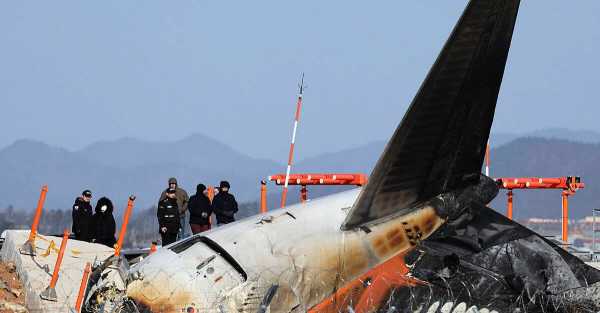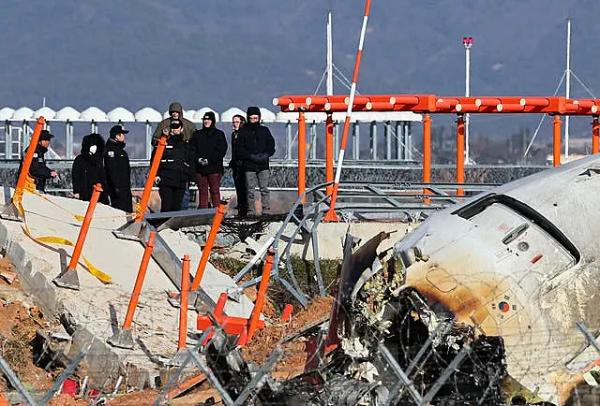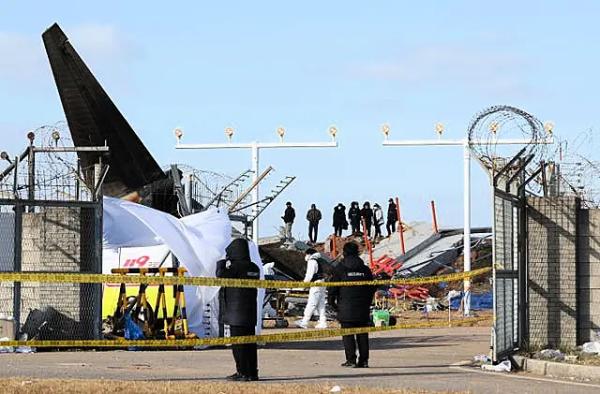
A team of US investigators including representatives from Boeing have examined the site of a plane crash that killed 179 people in South Korea.
The probe into the disaster in Muan continues as authorities conduct safety inspections on all Boeing 737-800 aircraft operated by the country’s airlines.
All but two of the 181 people aboard the Boeing 737-800 operated by South Korean budget airline Jeju Air died in Sunday’s crash.

Video shows that the aircraft, without its landing gear deployed, crash-landed on its belly and overshot a runaway at South Korea’s southern Muan International Airport before it slammed into a concrete barrier and burst into flames.
The plane appeared to develop engine trouble, and preliminary examinations also say the pilots received a bird strike warning from the ground control centre and issued a distress signal. However, many experts say the landing gear issue was likely the main cause of the crash.
The South Korean government has launched safety inspections on all the 101 Boeing 737-800s in the country. The Transport Ministry said authorities are looking at maintenance and operation records during five days of safety checks that are to run until Friday.
The ministry said that a delegation of eight US investigators – one from the Federal Aviation Administration, three from National Transportation Safety Board and four from Boeing – made an on-site visit to the crash site on Tuesday.

Kim E-bae, Jeju Air’s president, told reporters that his company will add more maintenance workers and reduce flight operations by 10-15% until March as part of efforts to enhance the safety of aircraft operations.
John Hansman, an aviation expert at Massachusetts Institute of Technology, said the crash was most likely the result of a problem with the plane’s hydraulic control systems. He said that would be consistent with the landing gear and wing flaps not being deployed “and might indicate a control issue which would explain the rush to get on the ground”.
The Boeing 737-800 – an earlier version of 737 than the Max – is a widely used plane with a good safety record, according to Najmedin Meshkati, an engineering professor at the University of Southern California who has studied aviation safety.
He said the failure of the plane’s system for broadcasting location, operating its landing gear and extending the wing flaps to slow down, indicate a widespread problem that affected electrical and hydraulic systems.
Mr Meshkati is confident that investigators will learn what went wrong by analysing information from the flight data and cockpit voice recorders.
“These are really the two pillars for accident analysis and accident reconstruction,” he said.
Like other aviation experts, Mr Meshkati also questioned the location of a solid wall just a few hundred feet past the end of the runway, given that planes do occasionally overshoot runways.
“Having such a big concrete barrier over there was really very bad luck for this particular aeroplane,” he said.
South Korean officials have said they will look into whether the Muan airport’s localiser – a concrete fence housing a set of antennas designed to guide aircraft safely during landings – should have been made with lighter materials that would break more easily upon impact.
The crash was the deadliest disaster in decades for South Korean aviation. A seven-day period of national mourning has been declared until January 4.
The Transport Ministry said authorities have identified 175 bodies and are conducting DNA tests on the remaining five.
Bereaved families said that officials told them that the bodies were so badly damaged that officials need time before returning them to relatives.
On Tuesday, Park Han Shin, a representative of the families, accused the government of failing to provide freezers on time as promised and said there are worries that the bodies could decompose.
“The last dignities of the victims are seriously hurt. We strongly criticise authorities for failing to keep its promise,” the representative said.
Sourse: breakingnews.ie






